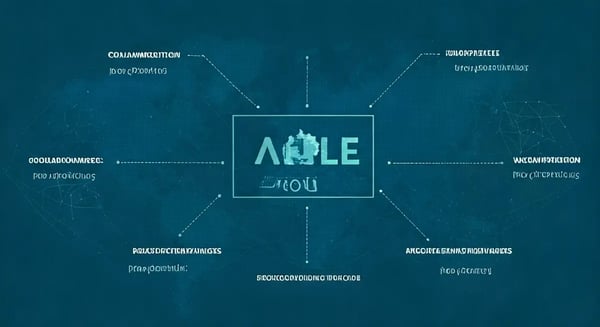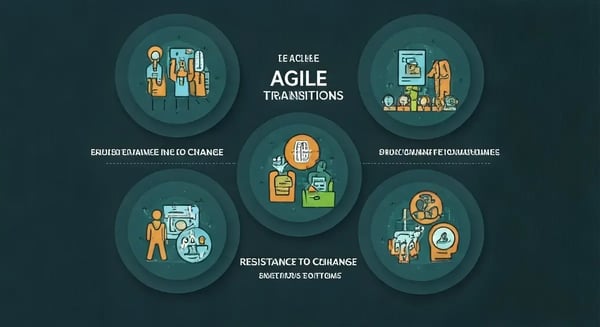Applying Agile Principles to Transition Projects | Adaptive US
Key Highlights
- Agile framework emphasizes flexibility, collaboration, and continuous improvement, making it essential for managing dynamic and evolving transition projects.
- Core values of Agile involve prioritizing people, adaptability, and ongoing delivery of value to customers or stakeholders.
- Agile methodologies like Scrum, Kanban, and Lean Startup offer tailored approaches for various project needs in dynamic environments.
- Effective transition projects rely on coordination, iterative development, and a focus on stakeholder engagement.
- Agile tools and practices foster collaboration, enhance feedback systems, and address challenges like resistance to change.
Introduction
The Agile framework has changed the way people do project management. It is used a lot in software development. Unlike older ways, Agile is flexible and helps with constant progress using things like sprint planning. Agile is now an important project management tool, especially for projects where things change quickly.
With Agile, you break work into short, manageable parts. This helps team members work together and stay in line with new business requirements. If you are new to Agile or looking for useful tips, this guide will show you how to use agile practices to handle transition projects in a better way.
Understanding Agile Principles in Project Management

Agile principles are important in project management. They help teams to make progress step by step, adjust to change, and work together. These principles make it easier for people to react fast and give high-quality results at the same time.
Many transition projects do not have clear requirements from the start, so the agile approach works well for them. The waterfall model uses a set order, but agile practices let teams make changes when they need to. When project goals match the needs of the business, agile practices keep the process moving and deliver value over and over again.
Definition and Core Concepts of Agile
The agile framework comes from the Agile Manifesto. It started as a flexible answer to the strict waterfall model. At the heart of the agile approach, teams work with change instead of against it. The focus is on being able to adapt, helping each other, and breaking work into steps.
Agile methods such as Scrum and Kanban work to keep customers happy. They do this by giving value a bit at a time. This way, things get better step by step. The workflow lets people share ideas and feedback at every part of the project. With close teamwork, it is easier to change what the team works on when needs shift.
The agile process also puts people first rather than following stiff rules. Using the ideas from the Agile Manifesto, teams switch from old written plans to real progress. Because of this, the agile framework brings together being flexible with getting things done. That makes it a good fit for new project needs.
The Evolution of Agile Methodologies
Agile methods have changed a lot since the Agile Manifesto came out in 2001. Before that, most people used the waterfall approach, which followed a step-by-step process. But, as the way we work changed, teams needed to be more flexible. So, new methods came along, like Agile, that let people adjust as they go.
With time, certain ways of working, like Extreme Programming and Scrum, became popular in Agile development. Extreme Programming focuses on technical work. Scrum has jobs like the Scrum Master. This helps teams know their roles and plan their sprints better.
Agile grew because the business world keeps changing. What started as a way to help with software development now reaches all sorts of jobs around the world. Agile’s main ideas help teams have both a plan and the freedom to shift when they need. This makes it good for projects that need to change and grow over time.
Key Agile Principles for Effective Transition Projects

Transition projects do well when teams use agile principles. These ideas include being open to change, working together, and breaking big tasks into smaller parts. This helps the team work better and still keep an eye on the business requirements.
When people from different groups work together and use steps to finish each part, agile practices help the project change easily when things do not go as planned. It also makes it easier to talk with everyone involved and fix problems as they come up. Using agile gives teams a clear way to make sure what they do matches what the business needs right now. Now, we will look at two main ideas that are important for agile in transition projects.
Emphasizing Collaboration Over Processes and Tools
The agile framework puts working together first. It does not depend too much on strict rules or just tools. In agile teams, team members come together as one group. They talk often to deal with problems as they come up. This focus on people helps them think of new ways to solve things.
Business processes do play a big part in how an organization runs each day, but agile values help the team work as one to deal with tough or new problems. Tools like Jira or Confluence can help, but talking to each other is still the key part of an agile framework.
Also, talking often with everyone involved, like stakeholders, makes things clear for all. For example, agile teams often have regular stand-ups. In these quick meetings, each person tells the group about their work and what is stopping them. This way of working makes things open and honest. It helps all stay focused together and meet business goals as a team.
Responsive to Change vs Following a Plan
Unlike older ways that stick to one plan, the agile approach and agile practices focus on being ready for change. Teams that use the agile approach expect business requirements to change, so they know how to adjust fast. This way, teams can avoid risks and help the project adjust better.
When changes happen in a project, people often see that plans and needs also change. Agile practices help teams set new priorities without losing track of bigger goals. If teams need to change plans in the middle of their work, agile practices let them do that easily.
Being able to change with the new business requirements makes customers happier, too. Teams work bit by bit so they can fix new problems as they come up. This helps the work stay steady but also lets teams change quickly when they need to. That way, teams can keep things organized and still change if they have to.
Agile Methodologies Applicable to Transition Projects
Agile methods give simple ways for software development teams to handle different kinds of projects. You can use Scrum when you want to work in short sprints. Kanban helps you by showing your work steps in a clear way. Lean Startup helps you change fast when you need to. Each of these ways can help with different problems and stages of a job.
These methods help not just software development teams, but also other groups. They can keep up as needs and goals change. With these Agile ways, your organization can reach its goals one step at a time, even as things shift and grow.
Scrum Techniques and Transition Project Management
Scrum is an agile methodology often used in transition projects that need both structure and room for change. The Scrum Master is a key person. He helps by leading daily meetings, fixing problems that come up, and supporting the team in sprint planning.
Each sprint focuses on what the development team needs to get done from the product backlog. People work together to finish top tasks, then they look back at their work during sprint retrospectives to find ways for continuous improvement. This way of working helps all of us build better teamwork and keep things clear.
Let’s say a software development team is building a new feature for an app. With Scrum, the team can split the work into user stories. They give work points for each task and meet each day to stay together on goals. This approach helps the team make steady and real progress, one step at a time.
Kanban as a Visual Project Management Tool
Kanban gives you a simple way to handle project management by showing tasks on boards and cards. You can track each task as it moves from one stage to another. This makes it easy for teams, especially when you are changing your project management strategy, to see where every task is and which ones may be slowing things down.
Continuous improvement is an important part of this method. Agile tools in Kanban help teams see their work at every step. Everyone knows what is going on, and this makes teamwork better. You can look at every task, from the first step to the finish, and see where things stand.
For example, if a logistics company is starting new ways of working, it can use Kanban boards to keep track of rules and updates. This project management framework helps make sure all tasks fit your new business goals, and it keeps important work running smoothly.
Lean Startup for Rapid Project Adaptation
The Lean Startup method helps teams move fast and change quickly with customer feedback. This agile approach lets you release a minimum viable product, or MVP, test it, and make changes again and again. By doing this, you cut down on the risks that come with long-term development.
Lean Startup places real customer feedback above any earlier guesses. This way, your product can match what customers really want. When you follow this process, you can keep up with the needs of the market and your team or customers.
Think about an online store that wants to try out new ways to pay. They can put out MVPs fast and see what customers think. This makes it easy to see which choices people like best, so the business can change right away. This is a good example of the agile approach in the Lean Startup way of doing things.
Steps to Implement Agile in Transition Projects

Adopting Agile in transition projects uses set steps. You first look at how ready you are, then build strong teams, and always work to get better. Agile works best in organizations that are open to change and that make sure the work lines up with their business goals.
To start using Agile, you should check your current workflow. After that, line up your way of working with Agile methods. Next, work on making good teams and add feedback loops so you can keep getting better. Let’s look more closely at these steps.
Initial Assessment and Agile Readiness
A good move to an agile framework starts with a full look at the current business processes. You need to see where the agile practices in the group stand right now. This first step gives a solid foundation for the steps after. Bring in the leadership team and the teams that do the work at the start. Their support helps a lot in making the agile transformation work out well. It is also key to know the customer needs. Use user stories to find out what people want. Check the amount of work needed, too. This work will help you choose which backlog items come first. These steps make for a more successful agile transformation.
Structuring Teams for Agile Transition
Having a good agile transition depends a lot on how you set up the teams. You need to make the roles of scrum master, product owner, and agile business analyst clear. This helps the team members know what to do and makes sure they work together. When you put all team members in cross-functional teams, people can talk more easily and understand what the business needs. It is also important to show each person that they have a vital role to play. This helps everyone take ownership and pushes them to keep learning all the time.
Getting the right structure for software development teams makes it easy to get feedback fast. This helps agile software development teams make changes to user stories when what the customers want changes. When you use this way in agile software, the group can keep up with new jobs, work well, and keep the business analyst and other team members connected.
Continuous Improvement and Feedback Loop
Continuous improvement depends on quickly using feedback in the agile process. By adding regular retrospectives, all team members have a way to tell what they experience and share what they think. This builds open talk in the group. In this way, agile teams can look at and change their user stories and backlog items, so they match better with customer needs and business goals.
When teams look at what they get by using key performance indicators (KPIs), they can change how they work if needed. This kind of feedback loop helps with agile transformation. It makes sure the work keeps up with the market, and it gives a solid foundation for new and ongoing projects to do well.
Tools and Technologies Supporting Agile Transitions
Using the right tools and technology can really help speed up an agile transformation. Project management software made for agile practices, such as Jira or Trello, is good for organizing tasks. It also helps teams manage their backlog, so they can pay more attention to user stories and sprint planning. For communication, tools like Slack and Microsoft Teams help team members work together, keep things clear, and make sure everyone stays on the same page.
These tools support the agile framework. They also help keep all team members, along with others involved, focused on what the business wants and what the customer needs during the whole development process. When you use these tools in the right way, you create a solid foundation for a successful agile transformation.
Project Management Software for Agile Settings
Selecting the right project management software has a vital role in making the agile process work well. The software helps teams see the product backlog and organize backlog items better. It lets people use story points, so they can know which tasks matter most. An easy-to-use interface gives team members fast access to user stories. This supports everyone to work together during the project.
With useful tools like sprint planning and ways to give feedback for continuous improvement, the team can do better work. These features help people react fast to customer needs. In the end, good project management software gives teams a solid foundation to reach business goals, even in complex projects.
Communication Tools to Enhance Team Collaboration
Using good communication tools is important to help team members work well together in agile teams. Tools like Slack and Microsoft Teams let everyone talk and share ideas quickly and easily. They help keep the lines open for feedback, which helps us all move toward the same project goals.
When it comes to seeing how things are moving, tools like Trello or JIRA give us a clear look at where work stands. They help us handle our project backlog and do better sprint planning.
This way, everyone stays connected and it is easier to avoid miscommunication. It helps support the agile process, keeps the focus on the needs of the business, and makes it simple to use customer feedback as the team keeps improving during each step of the project.
Challenges and Solutions in Agile Project Transitions

Moving an agile project from start to finish can be hard. There is often resistance to change, and it can be tough to keep all team members and stakeholders involved. One way to work past these problems is to support a culture of continuous improvement. Open talks with team members help make these changes easier for everyone. It is also important for the product owner to stay involved. This will make sure each of the user stories fits the business needs. Using feedback from everyone lets the team adjust their agile practices. In the end, all of this will help the group use the agile framework for the business in a better way.
Handling Resistance to Change
Resistance to change often shows up when there is a project transition in traditional project management. To help team members accept change, it is good to share a clear plan and reasons for using agile principles. When the leadership team joins in and talks openly with everyone, people begin to trust each other. This way, team members can talk about their concerns, and leaders can fix problems early. When experienced agile practitioners lead training sessions, people learn to work together better and do not feel as worried about the new ways of working. Focusing on continuous learning helps build a team culture that can handle change well. This support is important for a successful agile transformation and helps the business reach its goals.
Ensuring Consistent Stakeholder Engagement
Active participation from stakeholders is key for a good agile move. When team members and stakeholders talk often, it's easier to make sure work matches business needs and get feedback fast. By using agile practices like regular check-ins and group workshops, everyone can see what is happening. This helps build trust too. It lets all voices be heard in the development process.
Good ways to share information help team members and stakeholders stay connected. They make sure everyone knows about the project's progress and any issues that come up. When the team keeps people involved, it helps with better teamwork and makes people happier. It also keeps everyone working toward the same business goals.
Measuring Success in Agile Transition Projects
Success in projects that move to an agile process depends on having clear ways to measure how things are going. Key measures like sprint velocity and how many story points get finished help see how well agile teams be doing. Customer feedback also has a vital role. It helps check the business value of the project and makes sure you meet the business needs as they change. When you do regular checks, it helps everyone learn and get better, making continuous learning part of the work. With these metrics, you can see what the agile adoption is doing for you and can change your ways if you need to.
Key Performance Indicators (KPIs) for Agile Projects
Identifying key performance indicators, or KPIs, is important to see how well things are going in agile projects. When you focus on metrics like sprint velocity, lead time, and customer satisfaction, you help your team stay on track with business goals. Checking the amount of work that gets done compared to what was planned makes the development process more open and clear for everyone. Adding feedback loops lets the team change and adjust, which is a big part of agile practices. If your organization looks at KPIs on a regular basis, you can see how the agile approach is working for you. This way, you can make good choices to improve and move closer to a successful agile transformation.
Feedback Mechanisms and Learning Adaptations
Adding feedback into the agile process is key in software development. It helps make the way you work better. If the development team regularly reviews user stories and backlog items, it can point out what needs to get better. This makes sure the team stays focused on the business needs.
A way of continuous learning not only helps with agile transformation but also lets people share their thoughts easily. Getting and using customer feedback during every part of the software development process builds a culture of agility. This keeps the project moving toward its business goals and helps stop scope creep.
Conclusion
Bringing agile principles into transition projects can help make things work better and faster. When you use an agile approach in project management, you give your team members the power to handle changes in business needs quickly. This helps with continuous improvement during the development process. To get good results, it’s key to use the right tools and make sure team members work well together. Overcoming problems will be easier this way. If teams use agile practices well, they can reach business goals and give real value to the company. This change also helps lead the way to a new, creative way of managing projects in the future.
Frequently Asked Questions
What are the first steps in transitioning to an Agile project?
The first steps to start an agile project are simple. You need to see if your company is ready for change. It is also good to find out who the key people in the company are. After that, you should make teams that have people from different areas. These basic steps help set up the work for a good start with agile project methods.
How can Agile principles reduce project risks?
Agile principles help lower project risks because they make teams flexible and quick to act when things change. With frequent iterations, teams can spot any problems early on. This means there is less chance for small issues to become big risks. Also, by getting feedback all the time, teams make sure that stakeholder needs are being met. This keeps everyone on the same page and helps avoid unexpected problems as the project goes on.
What are common pitfalls in Agile transitions and how to avoid them?
Common problems in changing to agile can be not enough training, leaving out important people, and people not wanting things to change. To avoid these, you need to make training for all team members a top priority. Bring in everyone who should have a say and keep them included from start to finish. You must also help create a way for team members to be open to new things and to adapt quickly.

You May Also Like
These Related Stories

How to Prepare your Business for the Holidays

Pre-workshop preparation tips before attending Adaptive US classes



No Comments Yet
Let us know what you think